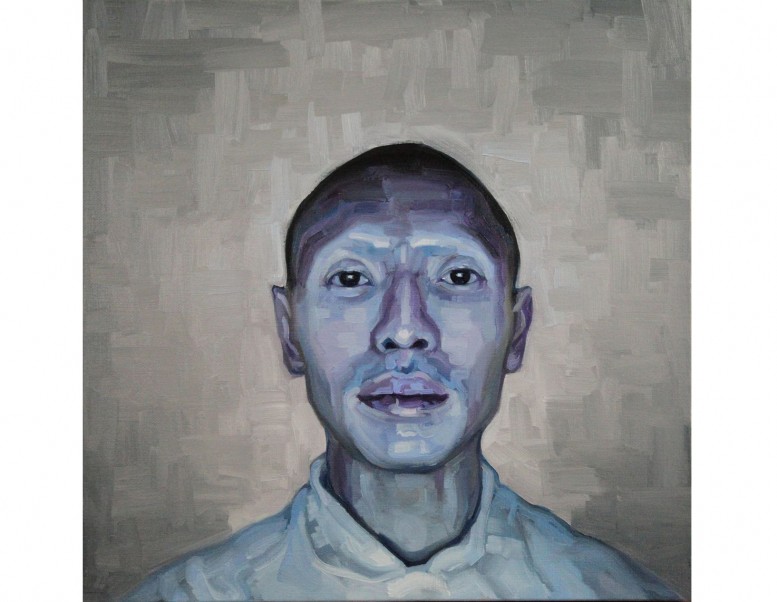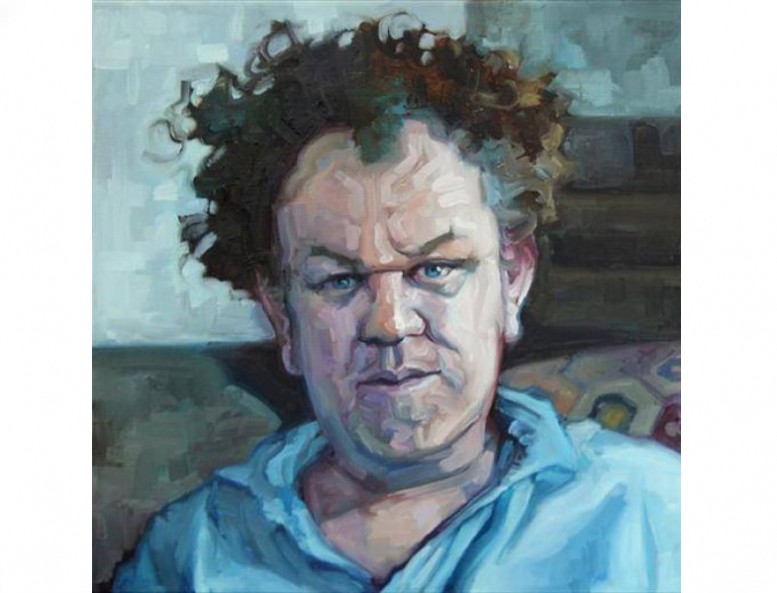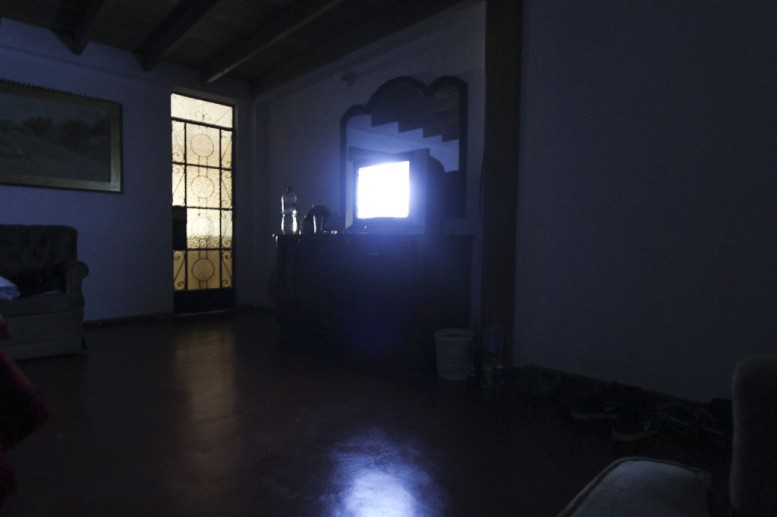Terence Koh
I imagine Joseph Rolin calling me on Skype late at night – drunk perhaps – angry at something or at nothing, but the internet is disconnected and his face is frozen on the screen, the image is almost impressionistic in its disintegrated, pixelated abstraction. Joseph Rolin would never Skype me of course, because Joseph Rolin existed in the 19th century – a postal worker and friend of Vincent Van Gogh and regular subject of some of his most famous paintings. Its not ridiculous to imagine….or is it? I'm simply trying to put figurative art in the context of a post-modern tool, not only for communication, but a medium for portraiture. Next week in New York artist Sandro Kopp will be exhibiting a series figurative portraits of subjects that include the likes of Haider Ackerman, Ryan McGinley, and Waris Ahluwalia. What is unique about Kopp's portraits is that his subjects were all painted during multiple hour sittings via Skype. Replace the chiaroscuro methods of the old masters with the faint cerulean glint of the millions of pixels of the computer screen and you have the brilliant electronic light that falls on the face of Kopp's portrait of actress Frances McDormand. With broad brush strokes you could say that Kopp's Skype portraits are a broad stroke of genius. I always think of the portraitist as a spiritual barber of sorts – hacking away at the aura of our spirit with a paintbrush instead of sheers; the setting personal, comfortable, with perhaps a sense eroticism in the intimacy between sitter and artist. However, in the fragmented and frenzied chaos of the collective pathos of the 21st century, a stage is set for mechanical or even electronic reproduction. Moreover, figurative art and the notion of painting from real life – not from photographs – or more appropriately google images – is a seemingly old fashion notion. Or is it?
Kopp, who was born in Germany and grew up in Wellington New Zealand, has found a unique niche with the use of Skype to paint his portraits. Kopp, who now lives in the Scottish Highlands, might even find it a hinderance to paint the variety of his subjects without Skype. Fittingly, I caught up with Kopp on Skype, where he is in New York readying for his solo show, entitled There You Are, at the Lehmann Maupin gallery as part of Istanbul 74' whose goal is to bridge the gap of the art, film and fashion world to one of Turkey's major cities . We talked about his earliest years and even earliest memories as an artist, we talked about his Skype portraits, and we talked about his inspirations and influences, but we also talked about the climate of figurative art in the 21st century. Where before our conversation I was intent on the notion that figurative art is old fashion, I was enlightened when I realized that Kopp just might be part of a new wave of post-modern figurative artists hitting the major galleries and museums. I think of the artist Alice Neel who lived in an almost netherworld for a female figurative artist of her era. Neel, who was born in 1900, had to wade through cubism, surrealism, abstract expressionism, minimalism, and pop art as female artist in a selective, male dominated arena. It wasn't until the mid-seventies when her striking portraits of friends, fellow artists, poets, and lovers became appreciated and Neel became a minor celebrity. Neel died in 1984 and her fame steadily rose with a major retrospectives exhibiting her work within the last decade, as well as a documentary in 2007, and you can't help but imagine what would happen if she were younger and alive today? Kopp, whose work could fall in the same vein as Neel, is in a new school of neo-figurativists like John Currin and Jenny Saville. Kopp, who is 33, has no definitive plans for the future except to keep making art and exploring his Skype portraits which he says on their own will evolve, with each exhibition offering something new, unexpected, and exciting.
Can you remember the first painting you ever painted? I can not, no. But there are drawings in existence that I did at less than 2 years old…..around 1 year…..I started pretty early. I have this page full of little objects which some are recognizable….some not…..and my mom has written beside what each one is….like, this one is a stone, this a snake, and she obviously asked me what's there and I wrote it down. So I was cataloguing stuff back then. That was my cataloguing phase (laughs).
So, you've always been an artist? I've never had a proper job if that's what (laughs)…..
No, I'm an artist as well and i'm the same way….I can't remember a time that I've not been an artist…..so thats interesting. And I read somewhere that you had you're first solo show when you were seven years old? What was that like….how did that come about? The whole concept of gallery and showing art and everything for children is very different. I was kind of bemused by it, but didn't really understand what an exhibition was….and when I was little I found going to museums incredibly boring. I still think its really important to take children to museums….I think its really great and one or two things will really stick. Its definitely more of a grown-up's game.
John C. Reilly
Do you remember going to museums when you were a kid….or anything that inspired you when you were younger? Yeah, although I have to say, and I think this is the way it goes, you're whole artistic sensibility matures with time and I was far more interested in natural history museums. Dinosaurs or paintings? Dinosaur skeletons…definitely (laughs).
And your Skype paintings….you've always been a figurative painter….you've always drawn, but do you feel like you found some kind of voice through the Skype paintings? Absolutely, yes. Well, voice maybe not, but I think I've found a very distinctive path to pursue…something really specific and to my knowledge I don't know anyone else who is doing specifically this thing, so I'm really happy that I found this and its been really interesting to me and it continues to be really interesting to me and its like I keep adding on another layer….I got this show in London in October and I'm going to be doing something slightly different along the same line…so its been a rich story to tell.
So, figurative art, especially in todays times almost seems old fashion, comparatively to other artists that are working today and are showing their work….I'm thinking of Damian Hirst and Jeff Koons who use big factories…..Damien Hirst and Jeff Koons do a lot of figurative work…
Thats true, but in the sense of painting to canvas…portraiture is essentially old fashion, but you have sort bridged this gap between that and this post-modernist element of using Skype….Yeah, I think there are a lot of figurative painters that are out there. There are not many at all, that I know of, that don't use photography as an intermediary step. I think a lot of figurative painting nowadays is based on photography in one form or another, like John Currin or Jenny Saville or Richard Phillips or also more abstract people like Peter Doig. I think there is a lot of figurative art out there….Chuck Close……but most of it has this step in between and in terms of people who really work directly from life....I know [David] Hockney does that sometimes…..[Lucien] Freud….god rest his soul…..he's no longer here, but he definitely did….he was the man when it came to that. Other than that, can you think of anyone?
Well, that is what I'm saying, especially Freud and Hockney, they sort of come from an old school of painting that was…..Well Freud yes, Hockney not so much….Hockney does whatever. I mean Hockney does large-scale video installations and working on Ipads and he uses photography a lot in his painting, but he also does work from life….he's out there in Yorkshire painting plein air…..old school….he does it all.
Michael Stipe
Do you take commissions? Yes.
Can you describe a typical Skype sitting? Sure, fix a time, fix a date….thats always very, very difficult and time consuming it seems (laughs). And it really depends on the sitter more than anything. I sort of follow their lead in terms of how communicative or silent they want to be….I really like both….in a funny way if you have a very lively conversation going its easier for me, because there is something to distract my conscious brain going on and my body, my hand-eye can sort of take over and do its thing and my brain doesn't really interfere that much. Having said that, often the very talkative sittings aren't necessarily the ones that lead to the best paintings. Some of the really quite silent sittings are in a funny way more intense….maybe its purer experience….. this thing of sitting and being seen and seeing someone. Its a relatively unique thing to do and if you allow it to be a silent moment I think that the specificity comes out more. Does that make sense?
Totally, that makes sense. I mean you do a lot portraits of friends and people you know, so the reason why I ask that is because it can be entirely different to paint a total stranger. Which I have done.
Do you have a favorite? Anyone thats been more engaging than anybody else? Well, I really like painting my friend Waris [Ahluwalia]….he's just super easy. We just have this ongoing conversation while we paint….either from life or from Skype and he is not only very distinctive looking and therefore easy to paint but also just a very easy to talk to person and so we have a lot fun when we're painting, but in terms of sitters for the show….I painted Terence Koh….do you know who I mean?
The artist? And he was very….he was wonderful….he was very silent….very quiet…..very still….very focused and the painting as a result is pretty dope I think and its really….if I dare say so myself….a very powerful image and so I think the fact that he was so silent and so focused on the process really helped that. I was completely exhausted at the end of it. I mean there was no chit chat to keep me going and to keep me relaxed…..I needed to go and lie down after I finished that painting.
Waris Ahluwalia
You said earlier that each one of your shows there is something different. What can we expect from your show next week? Well, one element to this show that I'm really happy with is recycling an idea earlier series called There You Are Dave, which is 20 paintings of the same guy…..its this guy David Le Fleming I painted from London who is a friend of mine….he's from New Zealand originally so we met there….we were in a couple of group shows way back when and then he moved to London and we re-connected and he was kind enough to sit for me 20 times…..I think his girlfriend really didn't like me at the end of it (laughs). Then putting that together you become aware of different they all are…..they really are 20 different paintings and completely different people in the paintings although they are all the same person. Part of that maybe is in the inaccuracies of what I'm doing, but part of it is also just I think whatever chemistry was that was brought to us on any given day and tying them together in a block in a sequence and thats something new that I haven't done on Skype before and I really like that. I had written on my easel….I've scrawled in pencil: "Make new mistakes," which I think is really important and thats an opportunity to do that you just start again…do the same thing again…and you become aware of what you are repeating and then you can correct that and you can make a new mistake. I love working repetitively. Its always really great to paint the same person several times. Its almost a sense of disappointment if I do a session with someone and it turns out too well on the first session, because I know the second one is not going to be as good as that if I do another one. Where if I mess up the first one up, I can do a second sitting and sometimes that can be a good one.
Did you go to school for art or study art or anything like that? I went to a school in New Zealand for a year.
Who are some artists you admire or are inspired by or influenced by? Hockney is definitely a thinker and a painter that I really like…..he gets my mind reeling and I love a lot of his work. I really like Ryan McGinley actually ….do you know who I mean?
The photographer? Yeah, the thing that I love about Ryan is the way that he is managing to do something with nudes…..I would love to be able to find something as powerful as he has with painting, but I think that with portraits its really easy to get a story because every person brings a story with them, but with nudes, especially painted from life, its much harder, and I'm working on that….I mean I've done a lot of nudes and I'm still working on that, but I don't necessarily show them that much and I hope in the next few years or so to crack that nut…..and come up with something really fresh to do with nudes….simply because you have to hold the same pose for three, four hours….there not much you can do with a naked body….there are some various but not holdable that amount of time. So, its difficult to come up with something new, whereas Ryan goes out and throws people off cliffs or puts them in caves and has them interact with wild animals….so they're just full of life! You know?
Yeah, his work is really beautiful. Really wild. And who else? Ask me on any given day and I'll give you different answer. Marlene McCarthy is really interesting….she is someone who I just discovered again….she's does those giant biro drawings….she did a whole thing with apes….very sexy…..very weird….very kind of ethereal, but drawn with ball point pen on huge pieces of paper. She's awesome. John Currin, definitely. I mean there is just all sorts of great people out there. And I do absolutely worship the old masters….I'll take Van Gogh any day. There is very exciting about seeing work by people who are still around. I really like going to galleries and discovering it a contemporary painter.
So you're interested exploring nudes. I mean whats next? I can't reveal my future plans yet…..for the mere fact that you say something and then life happens. Its a slippery slope to go down. I can that there is more painting…..there will be a show in London in October…..and there is both do more using technological mediation in one form or another…..and actually heighten the use of technology, but I'm also looking forward to doing some stuff that does't involve technology as a kind of sideline. I'm going to do both. And it will be more figurative painting…
ISTANBUL’74 presents There you are, an exhibition of new work by Sandro Kopp at Lehmann Maupin Gallery on view 25 January – 4 February, 2012 at 201 Chrystie Street. Text by Oliver Maxwell Kupper for Pas Un Autre
Kirsten Dunst and Sandro Kopp




















